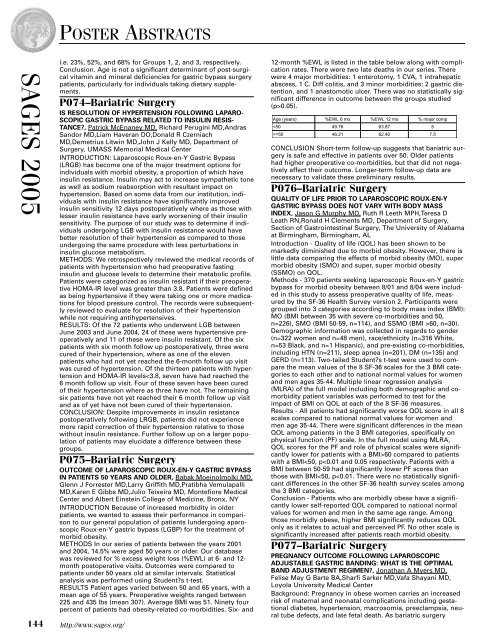2005 SAGES Abstracts
2005 SAGES Abstracts
2005 SAGES Abstracts
Create successful ePaper yourself
Turn your PDF publications into a flip-book with our unique Google optimized e-Paper software.
POSTER ABSTRACTS<br />
<strong>SAGES</strong> <strong>2005</strong><br />
i.e. 23%, 52%, and 68% for Groups 1, 2, and 3, respectively.<br />
Conclusion. Age is not a significant determinant of post-surgical<br />
vitamin and mineral deficiencies for gastric bypass surgery<br />
patients, particularly for individuals taking dietary supplements.<br />
P074–Bariatric Surgery<br />
IS RESOLUTION OF HYPERTENSION FOLLOWING LAPARO-<br />
SCOPIC GASTRIC BYPASS RELATED TO INSULIN RESIS-<br />
TANCE?, Patrick McEnaney MD, Richard Perugini MD,Andras<br />
Sandor MD,Liam Haveran DO,Donald R Czerniach<br />
MD,Demetrius Litwin MD,John J Kelly MD, Department of<br />
Surgery, UMASS Memorial Medical Center<br />
INTRODUCTION: Laparoscopic Roux-en-Y Gastric Bypass<br />
(LRGB) has become one of the major treatment options for<br />
individuals with morbid obesity, a proportion of which have<br />
insulin resistance. Insulin may act to increase sympathetic tone<br />
as well as sodium reabsorption with resultant impact on<br />
hypertension. Based on some data from our institution, individuals<br />
with insulin resistance have significantly improved<br />
insulin sensitivity 12 days postoperatively where as those with<br />
lesser insulin resistance have early worsening of their insulin<br />
sensitivity. The purpose of our study was to determine if individuals<br />
undergoing LGB with insulin resistance would have<br />
better resolution of their hypertension as compared to those<br />
undergoing the same procedure with less perturbations in<br />
insulin glucose metabolism.<br />
METHODS: We retrospectively reviewed the medical records of<br />
patients with hypertension who had preoperative fasting<br />
insulin and glucose levels to determine their metabolic profile.<br />
Patients were categorized as insulin resistant if their preoperative<br />
HOMA-IR level was greater than 3.8. Patients were defined<br />
as being hypertensive if they were taking one or more medications<br />
for blood pressure control. The records were subsequently<br />
reviewed to evaluate for resolution of their hypertension<br />
while not requiring antihypertensives.<br />
RESULTS: Of the 72 patients who underwent LGB between<br />
June 2003 and June 2004, 24 of these were hypertensive preoperatively<br />
and 11 of these were insulin resistant. Of the six<br />
patients with six month follow up postoperatively, three were<br />
cured of their hypertension, where as one of the eleven<br />
patients who had not yet reached the 6-month follow up visit<br />
was cured of hypertension. Of the thirteen patients with hypertension<br />
and HOMA-IR levels0.05).<br />
CONCLUSION Short-term follow-up suggests that bariatric surgery<br />
is safe and effective in patients over 50. Older patients<br />
had higher preoperative co-morbidities, but that did not negatively<br />
affect their outcome. Longer-term follow-up data are<br />
necessary to validate these preliminary results.<br />
P076–Bariatric Surgery<br />
QUALITY OF LIFE PRIOR TO LAPAROSCOPIC ROUX-EN-Y<br />
GASTRIC BYPASS DOES NOT VARY WITH BODY MASS<br />
INDEX, Jason G Murphy MD, Ruth R Leeth MPH,Teresa D<br />
Leath RN,Ronald H Clements MD, Department of Surgery,<br />
Section of Gastrointestinal Surgery, The University of Alabama<br />
at Birmingham, Birmingham, AL<br />
Introduction - Quality of life (QOL) has been shown to be<br />
markedly diminished due to morbid obesity. However, there is<br />
little data comparing the effects of morbid obesity (MO), super<br />
morbid obesity (SMO) and super, super morbid obesity<br />
(SSMO) on QOL.<br />
Methods - 370 patients seeking laparoscopic Roux-en-Y gastric<br />
bypass for morbid obesity between 8/01 and 8/04 were included<br />
in this study to assess preoperative quality of life, measured<br />
by the SF-36 Health Survey version 2. Participants were<br />
grouped into 3 categories according to body mass index (BMI):<br />
MO (BMI between 35 with severe co-morbidities and 50,<br />
n=226), SMO (BMI 50-59, n=114), and SSMO (BMI >60, n=30).<br />
Demographic information was collected in regards to gender<br />
(n=322 women and n=48 men), race/ethnicity (n=316 White,<br />
n=53 Black, and n=1 Hispanic), and pre-existing co-morbidities,<br />
including HTN (n=211), sleep apnea (n=201), DM (n=135) and<br />
GERD (n=113). Two-tailed Student?s t-test were used to compare<br />
the mean values of the 8 SF-36 scales for the 3 BMI categories<br />
to each other and to national normal values for women<br />
and men ages 35-44. Multiple linear regression analysis<br />
(MLRA) of the full model including both demographic and comorbidity<br />
patient variables was performed to test for the<br />
impact of BMI on QOL at each of the 8 SF-36 measures.<br />
Results - All patients had significantly worse QOL score in all 8<br />
scales compared to national normal values for women and<br />
men age 35-44. There were significant differences in the mean<br />
QOL among patients in the 3 BMI categories, specifically on<br />
physical function (PF) scale. In the full model using MLRA,<br />
QOL scores for the PF and role of physical scales were significantly<br />
lower for patients with a BMI>60 compared to patients<br />
with a BMI
















